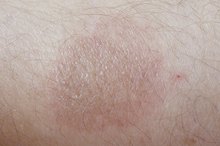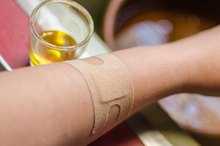How to Treat Burns From Cream Hair Removers
Chemical burns from hair depilatory creams, also known as hair removal creams, can be painful and leave a red rash and sometimes blisters on the affected area 2.
These burns are a result of sensitivity to the creams or from leaving the product on the skin for longer periods of time than instructed. Treating these burns should be done immediately to prevent scarring and deeper tissue injury.
Recognizing a Chemical Burn
Any of these symptoms can indicate a chemical burn, so be on the lookout:
- Pain or numbness at the site of contact
- Redness, irritation and burning
- Blisters or dead skin
A chemical burn might look fairly innocuous, but a serious one can be deceiving — it can cause deep tissue damage that isn't easy to spot by just looking at it, so if you're concerned, see a doctor.
Read more: Side Effects of Hair Remover
Treating Chemical Burns at Home
How to Prevent Scarring From a Steam Burn
Learn More
If you're developing a chemical burn from hair removal cream, rinse the burn with cool water immediately. Continue rinsing for 20 minutes in order to remove dirt and bacteria while cooling the burn. Do not apply soap or other cleansing agents to the burn when rinsing as this may cause irritation and dry the skin.
Apply a thin layer of antibiotic ointment to the burn to prevent infection of the damaged skin. Silver sulfadiazine is most commonly used in treatment of minor burns, and not only kills bacteria but also forms a seal to keep bacteria out of the wound.
You can also apply an analgesic gel to help with pain and inflammation as needed. Analgesic gels are topical pain relievers that help soothe skin irritations such as burns. However, do not use these gels if your burn results in broken skin as this can introduce bacteria into the wound and cause infection.
Cover the burn with gauze and secure with medical tape. Gauze provides a soft barrier over the burned skin without causing irritation. Gauze can be cut to size to fit burn areas that standard bandages cannot cover. Apply a bandage over antibiotic cream to prevent sticking to the wound.
- If you're developing a chemical burn from hair removal cream, rinse the burn with cool water immediately.
- Apply a thin layer of antibiotic ointment to the burn to prevent infection of the damaged skin.
When to See a Doctor
When the chemical burn first occurs, follow the at-home treatment guide. However, if the burn seems serious, if it seems to be spreading or it continues to increase in burn, visit the emergency room to let a doctor review the injury.
Related Articles
References
- Real Simple: Treating Minor Beauty Injuries
- eMedicineHealth: Chemical Burns
- Knowlin, L., Stanford, L., Moore, D., Cairns, B., & Charles, A. (2016). The Measured Effect Magnitude of Co-Morbidities on Burn injury Mortality. Burns : Journal of the International Society for Burn Injuries, 42(7), 1433–1438. http://doi.org/10.1016/j.burns.2016.03.007
- Hilton G. Thermal Burns: The ABCs are crucial, since the major threat is often inhalation injury. Am J Nurs. 2001;101(11):32-34. doi:10.1097/00000446-200111000-00017
- Cleveland Clinic. Burns. Updated August 31, 2017.
- Thom D. Appraising current methods for preclinical calculation of burn size - A pre-hospital perspective. Burns. 2017;43(1):127-136. doi: 10.1016/j.burns.2016.07.003.
- Knowlin, L., Stanford, L., Moore, D., Cairns, B., & Charles, A. (2016). The Measured Effect Magnitude of Co-Morbidities on Burn injury Mortality. Burns : Journal of the International Society for Burn Injuries, 42(7), 1433–1438.
Writer Bio
Sharin Griffin has been a freelance writer since 2009, specializing in health-related articles. She has worked in the health-care industry as a certified nursing assistant and medical technician. Griffin's medical expertise encompasses bariatrics and geriatric care, with an emphasis on general medicine. She is completing an associate degree in health-care administration from Axia University.







